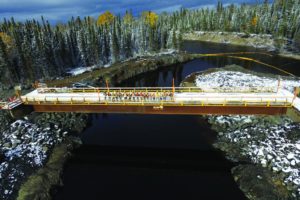


Episode 05
Chief Whetung and Sean Willy: Indigenous perspectives on cleaner energy
In the 21st century, on a warming planet, Indigenous knowledge will be essential to Canada’s journey toward a cleaner energy future. As our country begins its journey to reconciliation, these partnerships could provide a foundation for current and future generations.

Canada’s path towards reconciliation with Indigenous peoples starts with meaningful partnerships, and this is especially true in the energy industry. As Ontario Power Generation embarks on its ambitious, ten-year Reconciliation Action Plan, Andrea invites two Indigenous leaders onto the podcast to share their perspectives on nuclear, net-zero, “clean energy,” economic development, and the path towards a more united relationship.

Andrea’s first guest, Chief Emily Whetung of Curve Lake First Nation, used to view nuclear with skepticism but in her role as Chief, she has come around to view nuclear as an important part of the way we solve for climate change and create security for future generations. In this episode, Chief Whetung talks about her journey, the caveats we still need to include in discussions of “clean” energy, and the benefits of thinking about the next seven generations.
Andrea’s second guest, Sean Wily, is President and CEO of the Des Nedhe Development Corporation, which seeks to create sustainable employment and economic development opportunities for members of the English River First Nation. Sean has spent his career working to economically empower Indigenous communities with opportunities in the resource sectors. Sean shares his views on the role that nuclear energy can play both in advancing reconciliation with Indigenous people by creating economic opportunities and in tackling the global challenge of climate change.
Chief Emily Whetung: Nuclear Power, Relationship Building and the Seventh Generation
For Chief Emily Whetung of Curve Lake First Nation, nuclear power wasn’t something she thought too highly of—until recently. When she was first elected Chief in 2019, she viewed nuclear with suspicion. “Coming in I didn't know much about nuclear power but I had this idea that it was not good,” Chief Whetung told Andrea Bain on The Climate Challengers podcast.
But the closer she looked, the more she liked what she saw. “Having had an opportunity to engage with the energy industry in terms of climate change, I feel like I've learned that nuclear energy is way better,” the Chief said, referring to the fact that nuclear power has as small of a carbon footprint as wind and solar. “And finding out that nuclear energy is one of the cleanest types of energies kind of rocked my world. It shifted my whole perspective,” the Chief said.
Read more...
Curve Lake First Nation is located thirty minutes north of Peterborough, Ontario. The community of 2,000 is proud to offer its residents a host of social and community services, including childcare and elementary education for its youngest residents, but like other First Nations still struggles with issues like clean drinking water and being meaningfully consulted on projects that impact its traditional territories.
Chief Whetung sees that beginning to shift, as companies like Ontario Power Generation (OPG) get serious about fulfilling their role in reconciliation with Indigenous peoples. And for Chief Whetung, that begins with relationship building.
“Building that relationship between industry and government and First Nations, Indigenous people, is going to be critical moving forward,” Chief Whetung said, pointing out that these things take time and effort. “You don't just sit down and have a detailed, intimate conversation with someone you just met. Typically, you have to build up to that relationship.”
Building that trust and creating real partnerships where Indigenous people are given a seat at the table is critical because Indigenous people not only have treaty rights that must be honoured, they also bring unique perspectives to conversations around energy, climate and land use.
“I think there is a couple of things that the energy industry needs to understand about Indigenous people,” Chief Whetung said. “First and foremost, is that we're constantly thinking about our next seven generations. What does this thing that we're about to do have as an impact on those future generations? And our goal is to leave mother earth in as good a condition or better than we found it. And nuclear energy has long-term impacts into those generations, so addressing those issues is going to be really critical.”
Chief Whetung, who was a practicing lawyer before becoming chief, told Andrea that becoming a mother really helped crystalize her views. “Thinking about the two little boys that I have… I want a really great future for them. Knowing that, we've got to find an answer to this climate change emergency that's happening. [It] really shifted my perspective to consider nuclear in new ways and learn more about it.”
OPG’s generating assets and other facilities are on the treaty lands and traditional territories of Indigenous peoples throughout Ontario. Guided by its existing relationships with Indigenous communities, OPG is undertaking a multi-year initiative to further improve its relations with Indigenous peoples by ensuring they are meaningful partners who have input into—and benefit from—OPG’s activities.
On its last four renewable power projects, OPG entered into equity partnerships with local Indigenous communities that created immediate and lasting benefits. The 28-megawatt Peter Sutherland Sr. Generating Station, which entered service in 2017, is one of these projects. OPG’s partner in the development is Coral Rapids Power, a wholly owned company of the Taykwa Tagamou Nation (TTN). “We had 49 TTN members working on the project at one point in various capacities, which was significant for our First Nation partner,” said Paul Burroughs, Project Director at OPG. “They were part of the project team working to help make this a success.” With one third ownership of the project, the Peter Sutherland Sr. Generating Station will benefit the Takywa Tagamou Nation for another 90 years, as the community enjoys a share of the profits from their investment.
In 2021, OPG announced it was going further, with the formal launch of its Reconciliation Action Plan (RAP). The RAP is a ten-year road map that the leaders and employees of OPG will follow to advance reconciliation with Indigenous peoples. It brings every aspect of indigenous relations under one umbrella and is organized around five pillars: leadership, relationships, people, economic empowerment and environmental stewardship.
With a dedicated team of senior leaders within the company overseeing progress, the RAP aims to grow the economic impact of OPG’s operations for Indigenous communities and businesses to $1 billion within 10 years. Through the RAP, the company has also committed to increase the representation of Indigenous employees across all levels and businesses of OPG. To achieve this, OPG will continue to invest in its Indigenous Opportunities Network (ION), which is growing the Indigenous skilled talent pool within OPG and the broader energy industry.
Formally launched in 2018 as a partnership with Kagita Mikam, an Indigenous agency that provides training and employment services within the nuclear and energy industries, ION has successfully placed 52 Indigenous workers in various roles at OPG, exceeding its targets every year. In 2020, ION was expanded to include OPG’s entire operations. It will be a critical way in which OPG continues on its journey towards reconciliation.
“This is not just a plan. It is not just words. It is real action to create meaningful change and it will help our country in its work to achieve reconciliation with Indigenous peoples,” said Christine John, a Senior Adviser in Indigenous Relations at OPG. “For me, there are many ways towards reconciliation, but reaching net-zero in partnership with Indigenous communities is one that really gets me excited. Achieving something so big and so important together as partners will set us on the right path for future generations.”
Chief Whetung takes a similar view, but added that we also must keep in mind the bigger picture, telling Andrea that “Canada's path to reconciliation is broad and huge. And absolutely energy has to be a part of that path, but it can't be the only part.”
For Chief Whetung, being a Climate Challenger “means finding solutions to protect the earth for those seven generations. And ultimately, I think everything for me comes back to that… I want them to have a healthy life. I want them to have a meaningful and fulfilled life. And in order to do that, we have to find solutions to some of the issues that are facing us right now.”
Sean Willy: Indigenous Empowerment and Clean Energy in Canada
Sean Willy has devoted his career to empowering other Indigenous people through economic development—and he has a lot to say on the subject, having spent more than twenty years in the resource industry. In 2017, Sean was appointed President and Chief Executive Officer of the Des Nedhe Group, which aims to grow sustainable employment and business opportunities for English River First Nation community members. To hear his perspectives on the relationship between reconciliation, Indigenous empowerment, energy and economic development, and net-zero, Andrea invited Sean onto The Climate Challengers podcast.
The first thing Sean wants you to understand is that, growing up in the Northwest Territories as the son of a mining executive father and First Nations mother, Indigenous inclusion was ingrained in him from an early age. “It was because it was the right thing to do,” Sean told Andrea, explaining that his father’s goal was to ensure Indigenous people were at the table for resource development projects because doing so would benefit all of Canada. Sean has never forgotten this.
Read more...
The second thing Sean wants you to know is that he is firmly pro-nuclear, telling Andrea that “nuclear power offers us this baseload carbon-free option... And in Canada, we have world-class mining operations. We have world-class fuel fabrication in Southern Ontario. We have world-class nuclear power operators in Ontario and New Brunswick. If you understand that we have to decarbonize the planet, we have to be strong and we have to push nuclear.”
But Sean is also well aware of the hesitations Indigenous communities continue to have about nuclear energy. “It's funny, when you find diamonds and gold on Indigenous people's land… there's a little bit of excitement. When you find uranium, there's a little bit of apprehension.”
In Sean’s view, the best way to overcome these fears is by meaningfully involving Indigenous partners from the very start. “We want to be part of the environmental discussions. So if we're part of the environmental discussions upfront and our traditional knowledge, and our way of thinking was incorporated when you built a product, maybe it's more sustainable… If we're part of the ongoing monitoring of the environment while a project is going on, you're going to have a firsthand involvement from our elders and our knowledge keepers. And if we're involved in the reclamation and decommissioning aspects of it, we know [about] the disturbance of the land. So if you're building hydro or you're building a solar farm, or even putting in a small nuclear plant, you're going to get the land back to normal as much as possible with Indigenous involvement.”
Across Canada, Indigenous communities have been significantly involved in more than 197 clean energy projects over 1 MW, which according to one study accounts for 5% of Canada’s clean energy activities. This involvement ranges from Impact Benefit Agreements to direct ownership of projects. Sean’s work is focused on making sure this number increases, because he has seen firsthand the benefits of economic involvement and development for Indigenous communities.
“Our economic development corporation was set up for, yes, we want to create own-source revenue, but we also want to employ people because I think the biggest driver we can do is employ more people. To break the cycle of dependence and create role models for the future. And I think it's that holistic viewpoint that is why we're a game-changer for helping solve the climate change discussion right now,” said Sean. “And I think now as Indigenous people in this country, we have to take that business mindset and click that action in the concept.”
Reconciliation with Indigenous peoples in Canada is a vast, multi-generational process that the country has only begun to engage with. There is still lots of work to do, trust to build and relationships to mend. But looking at reconciliation through the lens of energy development offers some hopeful signs. OPG is committed to engaging with Indigenous communities as partners as it works to become net-zero by 2040—and beyond. With everything Sean has achieved throughout his career and at the Des Nedhe Group, there are many hopeful signs demonstrating how low emission energy projects can benefit Indigenous communities while also bringing the whole country closer to both net-zero and reconciliation. And for Sean, that is what being a Climate Challenger is all about.
“I think as a climate challenger… Indigenous people want to play a role in solving the carbon issue. And as an Indigenous group, leading the charge by raising our hands saying, ‘we want to invest in small nuclear reactors. We want to work on current nuclear reactors. We want to work in current nuclear plants,” concluded Sean.
Facts about Indigenous peoples
1.67 million
people self-identify as Indigenous in Canada (4.9%)
42.5% growth
Indigenous people were the fastest growing population in Canada from 2006 to 2016
197
clean energy projects across Canada (over 1 MW) have involved Indigenous communities
2nd largest
producer of uranium in the world is Canada
Indigenous topics
Other episodes
The information, statements, comments, views and opinions expressed during this podcast are solely those of the program participants and do not necessarily represent those of Ontario Power Generation Inc. or its affiliates.











